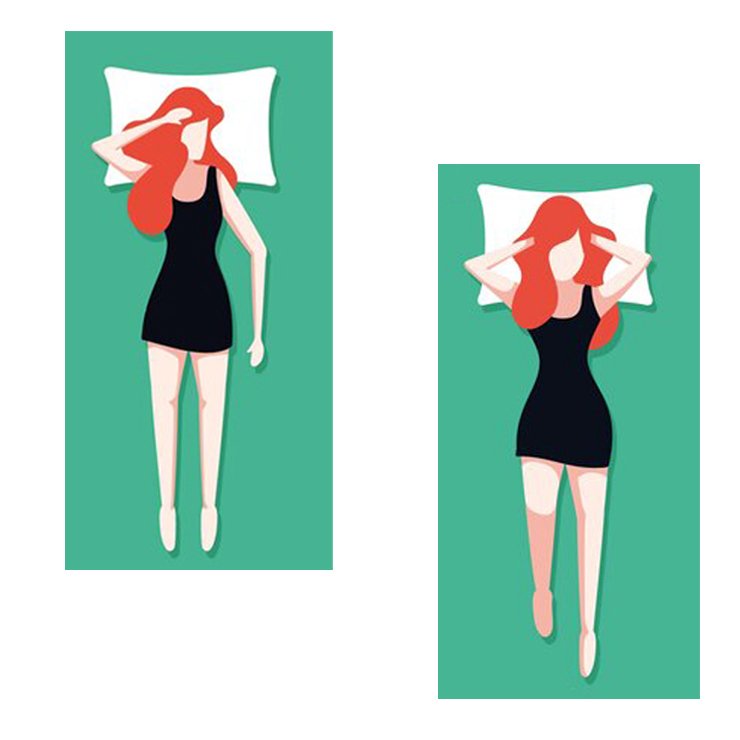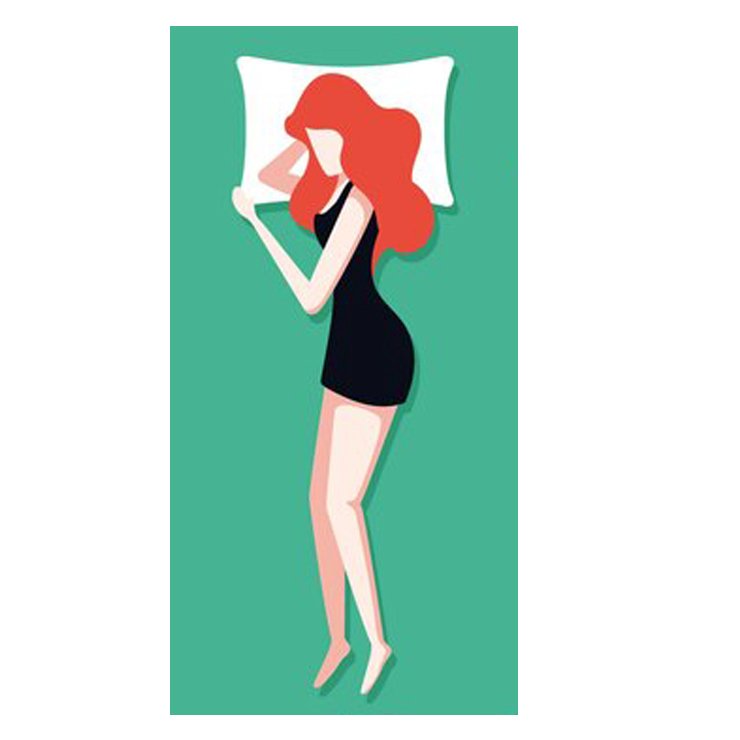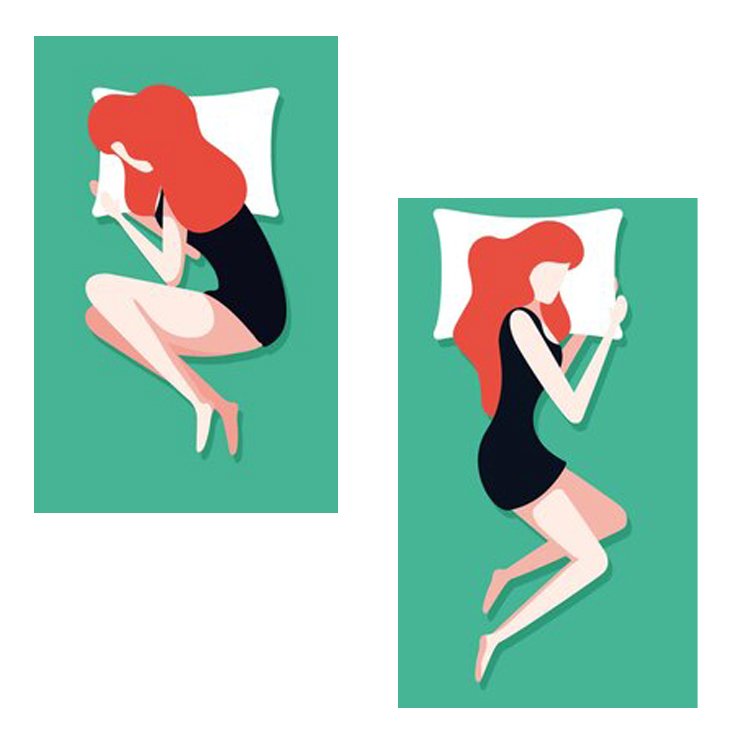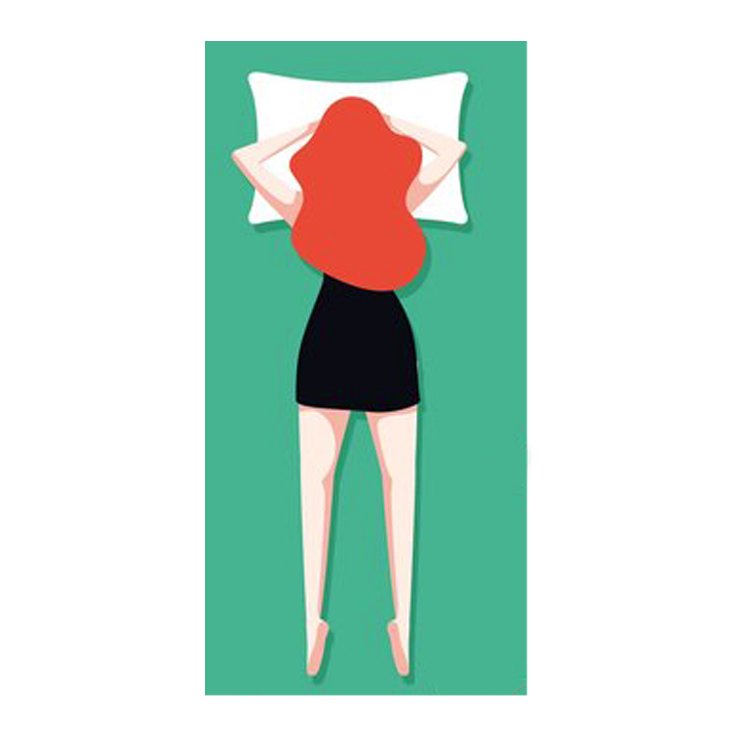
What is your favourite sleeping position? Here is its amazing significance on your personality
The best sleeping position varies from person to person, depending on individual health concerns, comfort preferences, and whether they’re dealing with specific issues like pregnancy, snoring, or back pain. For instance, side sleeping is often recommended for pregnant women, while back sleeping may be better for those with certain types of neck and spinal issues. It’s essential to listen to your body and consider any advice from healthcare professionals regarding the best sleeping posture for your specific health needs.
Type of sleeping position
- Back Sleeping (Supine Position):
- Side Sleeping:
- Fetal Position (A Variation of Side Sleeping):
- Stomach Sleeping (Prone Position):
- Combination Sleeping:
Sleeping positions can vary widely among individuals, each with its own set of benefits and potential drawbacks. Here are the most common types:
-
Back Sleeping (Supine Position):

Back sleeping, also known as the supine position, involves lying on your back with your face upwards and your arms either by your side or resting on your stomach or chest. This sleeping position is often recommended for its potential benefits to spinal health, as it allows the spine, neck, and head to rest in a neutral position, aligning with the body’s natural curvature. However, like all sleeping positions, it has both advantages and disadvantages.
Advantages of Back Sleeping
- Spinal Alignment: Maintains natural alignment of the spine, neck, and head, which can help reduce pain and discomfort associated with spinal misalignments.
- Reduced Facial Wrinkles: Sleeping on your back prevents the face from being pressed against a pillow, which can reduce the development of sleep wrinkles and premature aging signs.
- Even Weight Distribution: Helps distribute body weight evenly across the widest surface of the body, minimizing pressure points and contributing to overall musculoskeletal health.
- Minimizes Acid Reflux: When the head is elevated with pillows, back sleeping can help prevent acid reflux by keeping the stomach below the esophagus, making it harder for stomach acids to come up the digestive tract.
Disadvantages of Back Sleeping
- Snoring and Sleep Apnea: This position can exacerbate snoring and obstructive sleep apnea. The gravity effect can cause the tongue and soft tissues at the back of the throat to collapse, narrowing the airway and leading to breathing difficulties during sleep.
- Lower Back Pain: Without proper support, this position can sometimes lead to or exacerbate lower back pain. Placing a pillow under the knees can help maintain the natural curve of the lower back and alleviate discomfort.
Tips for Back Sleepers
Use a Supportive Pillow: A pillow that supports the natural curve of your neck while not lifting your head too much is ideal. Memory foam or a pillow with a cervical contour can be beneficial.
Place a Pillow under Your Knees: This can help maintain the natural curve of your spine and reduce strain on your lower back.
Ensure Mattress Support: A medium firm mattress often provides the best support for back sleepers, offering a good balance between comfort and spinal support.
Consider Snoring and Sleep Apnea: If you suffer from snoring or sleep apnea, consult with a healthcare professional for potential treatments. Specialized pillows and CPAP machines can help manage these conditions.
Choosing the right sleeping position is a personal decision that should consider health issues, comfort preferences, and any advice from healthcare professionals. For many, the benefits of back sleeping make it a preferred choice, especially when accompanied by adjustments to enhance comfort and mitigate any disadvantages.
-
Side Sleeping:

Side sleeping is one of the most common sleeping positions, where an individual lies on their side, with their legs stacked or slightly bent. This position can further be categorized based on how the arms are positioned or the degree to which the legs are bent. For example, the fetal position is a type of side sleeping where the legs are more significantly bent, often up towards the chest. Side sleeping offers several health benefits but also has potential downsides depending on an individual’s health conditions or preferences. It’s generally considered a good position for alleviating certain health issues.
Variations of Side Sleeping
Fetal Position: Knees are drawn up towards the chest, mimicking the position of a fetus in the womb. This is a very common variation of side sleeping.
Log Position: The sleeper’s legs are relatively straight, and the arms are kept down along the body.
Yearner Position: The sleeper extends their arms out in front of the body, as though reaching for something.
Advantages of Side Sleeping
- Reduced Snoring and Sleep Apnea: Side sleeping can help keep the airways open, making it beneficial for those who snore or have obstructive sleep apnea.
- Alleviates Acid Reflux: Sleeping on the left side, in particular, can reduce symptoms of acid reflux and heartburn by preventing stomach acid from travelling up the esophagus.
- Enhanced Brain Health: Some research suggests that side sleeping can help with the brain’s glymphatic system, potentially aiding in the clearance of brain waste and reducing the risk of neurological diseases.
- Pregnancy Comfort: Side sleeping, especially on the left side, is recommended for pregnant women to improve circulation to the heart and provide the best nutrient flow to the fetus.
- Spinal Alignment: With proper support, side sleeping can maintain good spinal alignment, reducing the risk of back and neck pain.
Disadvantages of Side Sleeping
- Shoulder and Hip Pressure: Prolonged pressure on the shoulder and hip on the side you’re sleeping can lead to discomfort and pain.
- Facial Wrinkles and Sagging: Sleeping on one side of the face can contribute to facial wrinkles and potentially lead to sagging over time due to pressure and friction against the pillow.
- Uneven Spinal Alignment: Without the right mattress and pillow support, side sleeping can sometimes lead to or exacerbate spinal misalignment and discomfort.
Tips for Side Sleepers
Use a Thick, Supportive Pillow: To keep your head and neck aligned with your spine, use a pillow that fills the gap between your head and the mattress without tilting your head upwards or downwards.
Place a Pillow Between Your Knees: This can help maintain hip alignment and reduce stress on your lower back.
Choose the Right Mattress: A mattress that contours to your body can provide support while alleviating pressure points on the shoulder and hip.
Alternate Sides: If possible, try to switch sides throughout the night or over time to prevent imbalances and reduce pressure on one side of your body.
Selecting the best sleeping position is a personal choice influenced by various factors, including comfort, existing health conditions, and specific needs like pregnancy. Side sleeping is widely recommended for its health benefits, but it’s important to ensure proper support to maximize its advantages and minimize any potential downsides.
-
Fetal Position (A Variation of Side Sleeping):

The fetal position is a variation of side sleeping and is one of the most popular sleeping positions. It involves lying on your side with your knees pulled up towards your chest and your chin tucked down, somewhat resembling the posture of a fetus in the womb. People often find this position comforting and naturally adopt it during sleep due to its cozy and secure feeling.
Advantages of the Fetal Position
- Comfort and Security: Many people find the fetal position comforting, as it can mimic the warmth and security of being in the womb. This can contribute to falling asleep faster and more deeply.
- Reduced Snoring: Side sleeping, including the fetal position can help reduce snoring and the symptoms of mild obstructive sleep apnea by keeping the airways open more than back sleeping.
- Improved Digestion: The fetal position can aid digestion and might help reduce acid reflux and heartburn, especially when sleeping on the left side, as it prevents stomach contents from flowing back into the esophagus.
- Beneficial for Pregnant Women: It is often recommended for pregnant women, particularly in the later stages of pregnancy, as it improves circulation to the heart, benefiting both the mother and the baby.
Disadvantages of the Fetal Position
- Joint and Back Pain: Curling up too tightly can restrict diaphragmatic breathing, and putting too much pressure on your knees and chest can lead to joint pain, lower back pain, or even long-term posture issues.
- Restricted Breathing: The curled up nature of this position can also restrict breathing and limit diaphragmatic breaths, potentially leading to a less restful sleep.
- Facial Wrinkles and Breast Sagging: Pressing your face against the pillow can contribute to facial wrinkles over time. For some women, sleeping in the fetal position might also contribute to breast sagging due to the gravitational effect.
Tips for Sleeping in the Fetal Position
Don’t Curl Up Too Tightly: Try to relax your body as much as possible. Keeping your posture looser can help avoid joint and back pain and facilitate easier breathing.
Switch Sides: Alternating sides can help prevent imbalances and discomfort caused by always sleeping on the same side.
Use a Pillow Between Your Knees: Placing a pillow between your knees can align your hips better, reducing the strain on your lower back.
Choose the Right Mattress and Pillow: A supportive mattress that contours to your body can prevent you from sinking in too deeply. A thick, supportive pillow can help keep your neck aligned.
While the fetal position has its advantages and disadvantages, it remains a favoured choice for many due to its inherent comfort and sense of security. Making slight adjustments can help mitigate some of the potential negative impacts, ensuring a more restful and healthful night’s sleep.
-
Stomach Sleeping (Prone Position):

Stomach sleeping, or the prone position, involves lying on your stomach with your face down towards the pillow and your arms positioned around the pillow or alongside your body. While it is less common than back or side sleeping, some people find this position comfortable and naturally prefer it for sleeping. However, stomach sleeping is often discouraged by healthcare professionals due to the potential for negative health impacts, particularly on spinal alignment and neck strain.
Advantages of Stomach Sleeping
- Reduced Snoring and Sleep Apnea: Stomach sleeping can help reduce snoring and the symptoms of sleep apnea for some individuals by keeping the airways more open compared to back sleeping.
Disadvantages of Stomach Sleeping
- Neck and Back Strain: To breathe, you must turn your head to one side while in the prone position, which can put a significant strain on your neck and spine. This unnatural twist can lead to chronic neck pain, back pain, and other musculoskeletal issues over time.
- Spinal Misalignment: This position does not support the natural curve of your spine, leading to potential misalignment and strain on your back. Unlike back or side sleeping, the prone position can exert unnecessary pressure on the middle section of your body, contributing to lower back pain.
- Facial Wrinkles: Stomach sleepers may experience an increase in facial wrinkles due to the face being pressed against the pillow for extended periods.
- Breast Strain: For women, lying on the stomach can put additional pressure on the breasts, leading to discomfort.
Tips for Stomach Sleepers
Use a Thin Pillow or No Pillow: To minimize neck strain, consider using a thin pillow for your head or even no pillow at all. This can help keep your neck more aligned with your spine.
Place a Pillow under Your Pelvis: Adding a thin pillow under your pelvis can help lift your spine into a more natural alignment, reducing the strain on your back.
Stretch in the Morning: Doing gentle stretches when you wake up can help alleviate some of the tension and discomfort caused by the prone position.
Transition to Another Sleeping Position: If you’re experiencing discomfort or pain from stomach sleeping, consider gradually transitioning to a side or back sleeping position. This can be a challenging adjustment, but it may significantly improve your overall spinal health and reduce pain.
Despite its disadvantages, some people continue to find stomach sleeping the most comfortable position. Being mindful of the potential issues and making adjustments where possible can help mitigate some of the negative effects associated with the prone sleeping position.
-
Combination Sleeping:

Combination sleeping refers to the practice of changing sleeping positions throughout the night. Combination sleepers do not stick to one position, such as back, side, or stomach sleeping, but instead move between two or more positions. This sleeping style is quite common, as many people shift positions during the night to find the most comfortable posture or to relieve pressure points.
Advantages of Combination Sleeping
- Reduced Pressure Points: Moving around during sleep can help distribute body weight more evenly, reducing pressure on any one area of the body. This can minimize the risk of pain or discomfort in areas like the hips, shoulders, and back.
- Improved Circulation: Changing positions can encourage better blood flow and prevent circulation problems that sometimes occur from staying in one position for too long.
- Versatile Benefits: Because combination sleepers move through different positions, they may be able to enjoy the benefits of each position, such as reduced snoring from back sleeping and decreased acid reflux from side sleeping.
Disadvantages of Combination Sleeping
- Fragmented Sleep: Frequent movement can lead to disruptions in sleep, especially if the movements are significant enough to fully awaken the sleeper. This can impact sleep quality and lead to feelings of restlessness or fatigue during the day.
- Difficulty Finding the Right Mattress and Pillow: Since combination sleepers need support for multiple positions, finding the ideal mattress and pillow that accommodate all sleeping styles can be challenging. A medium firm mattress is often recommended for its versatility.
Tips for Combination Sleepers
- Use a Supportive Mattress: A medium firm mattress that adapts to the body’s movements and provides adequate support for various positions is ideal for combination sleepers.
- Choose an Adjustable Pillow: A pillow that can be adjusted for firmness and height can help accommodate the different needs of each sleeping position, ensuring proper alignment of the spine and neck.
- Practice Good Sleep Hygiene: Establishing a consistent bedtime routine, reducing exposure to screens before bed, and creating a comfortable sleep environment can help improve sleep quality, even if you change positions throughout the night.
- Be Mindful of Position Transitions: Try to be conscious of how you move during sleep. Gentle transitions and avoiding abrupt or forceful movements can help maintain a restful sleep.
Combination sleeping naturally aligns with the body’s need to adjust for comfort and pressure relief throughout the night. While it may come with the challenge of optimizing sleep setup for multiple positions, understanding the needs associated with each sleeping posture and making appropriate adjustments can lead to a comfortable and restorative night’s sleep.
Choosing the right sleeping position can depend on various factors, including personal comfort, any existing health conditions (such as back pain, acid reflux, or sleep apnea), and whether you’re pregnant. Adjusting your sleeping position for better alignment and support can significantly impact your sleep quality and overall health. For specific concerns, it may be beneficial to consult with a healthcare professional.
Conclusion:
There is no one size fits all answer to the best sleeping position; it ultimately depends on individual preferences, health considerations, and how each position impacts your sleep quality and physical wellbeing. Listening to your body, making adjustments for comfort and support, and addressing any sleep related health issues with a healthcare provider are key to achieving restful and restorative sleep, regardless of your preferred sleeping position.
